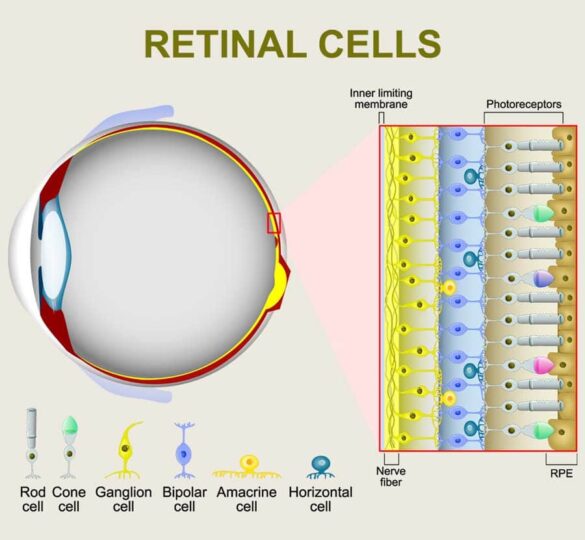Research On Retinal Pigment Epithelial (RPE) Cells Promises New Future Treatment for Glaucoma Patients
Glaucoma doesn’t typically damage RPE cells, but thanks to advances in stem cell research, it looks like RPE cells may play a crucial role in finding a cure to the degenerative disease.

Scientific research builds its own momentum as one discovery triggers another, building an ongoing wave of unexpected possibilities. In the world of glaucoma, such a surge began when advances in stem cell research opened doors experts had never imagined.
With this new perspective, they began to consider innovative ways to use specialized cells in the eye, like retinal pigment epithelial cells and ganglion cells. Today researchers continue to follow that path, knowing that each small step they take may lead to future glaucoma treatments.
What Are Retinal Pigment Epithelium (RPE) Cells?
Most people know at least a little about the retina. The retina is a thin tissue that’s about an inch in diameter, yet it contains all the photoreceptor cells responsible for beginning vision and their circuits that produce signals that become vision.
If you could look beneath the retina, you’d find a sheet of black cells called the retinal pigment epithelium, (RPE). The easiest way to describe the RPE is to say it supports the retina, but that doesn’t begin describe its value. These cells help by renewing the light-absorbing pigments contained in the rod and cone photoreceptors on a daily basis. They also enhance vision by absorbing scattered light. They ensure survival of photoreceptor cells by delivering nutrients, while also serving as a barrier that blocks damaging substances from getting into the retina. The RPE also stops free radicals before they can damage the retina.
The retinal pigment epithelial cells are shaped like a six-sided hexagon, so they fit together as tight as a puzzle. Tiny projections extend from RPE cells, reach out to cover photoreceptor cells and carry nutrients into the cells. When RPE cells are damaged, photoreceptor cells die, ultimately leading to blindness.
What do RPE Cells Have to do Glaucoma?
Glaucoma doesn’t typically damage RPE cells, but thanks to advances in stem cell research, it looks like RPE cells may play a crucial role in finding a cure to the degenerative disease. Experts have been studying stem cells for the last seven decades, but their time and effort is beginning to pay off.
Researchers discovered that mature stem cells from various places in the body can be removed and injected with a combination of genes that reprogram the adult cells back into their fresh embryonic state. These cells are called induced pluripotent stem cells. This has been put into practice in the lab, where adult stem cells taken from bone marrow were reprogrammed to grow into various eye cells.
When certain induced pluripotent stem cells are grown together with RPE cells, they can be reprogrammed to turn into photoreceptor cells and other retinal cells. It may even be possible to develop a group of protective nerve cells in the retina—retinal ganglion cells—that are damaged by glaucoma. While these amazing discoveries have yet to take shape as a viable treatment option for glaucoma, they certainly make it possible to believe that research using RPE cells may one day lead to a novel stem cell-based treatment that could stop or even reverse the progression of glaucoma.
It is research like this, funded by people like you, that gives hope to the glaucoma community. Your generous donation to Glaucoma Research Foundation goes to support researchers developing the next generation of glaucoma treatments.
Posted on February 17, 2017; Reviewed on April 20, 2022.